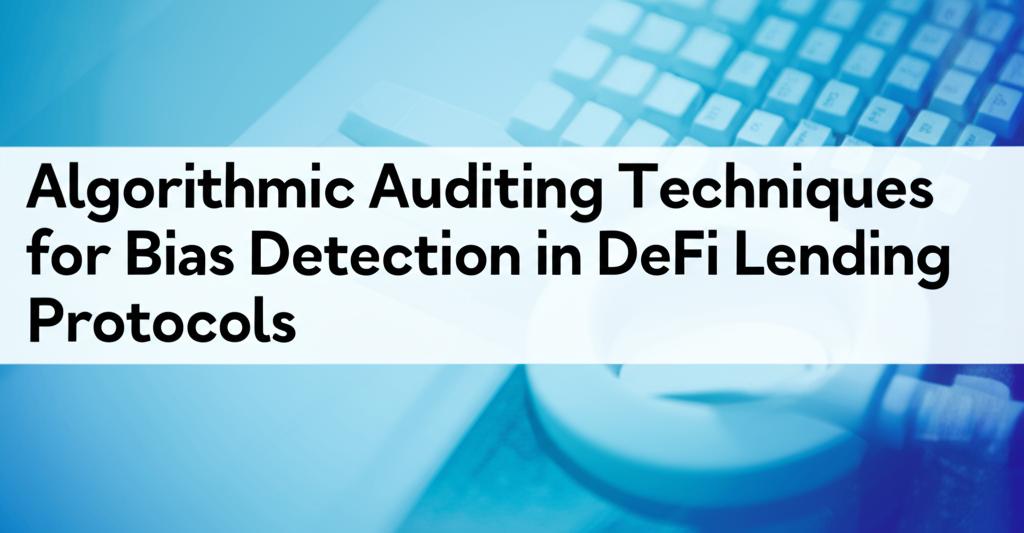Decentralized Finance (DeFi) lending protocols promise a more open and accessible financial system. By removing traditional intermediaries, these platforms leverage algorithms and smart contracts to automate loan origination, collateralization, and interest rate determination. However, the very algorithms designed for efficiency and impartiality can inadvertently harbor or even amplify biases, leading to unfair treatment of users. Algorithmic auditing offers a pathway to identify and mitigate these risks, ensuring DeFi stays true to its democratizing ethos.
Understanding the Specter of Bias in DeFi LendingBias in DeFi lending can manifest in several ways. It might appear as discriminatory outcomes in loan approvals, where certain wallet addresses or those interacting with specific assets receive less favorable terms. It could also be seen in the setting of interest rates or collateralization ratios that disproportionately disadvantage some participants. While DeFi aims for pseudonymity, on-chain data can sometimes reveal patterns or allow for proxy attributes that algorithms might unintentionally learn to discriminate against. Sources of bias can range from the training data used for any machine learning components, the design choices embedded within the protocol's logic, to the oracles supplying external data. The consequences of unchecked bias include eroding user trust, creating systemic unfairness, and potentially inviting regulatory scrutiny.
Core Techniques for Algorithmic Auditing in DeFiAuditing DeFi lending protocols for bias requires a multi-faceted approach, blending data analysis, model inspection, and simulation. Here are some key techniques:
- Data-Driven Analysis:
Transaction Pattern Recognition: Auditors scrutinize historical transaction data on the blockchain. They look for statistical disparities in loan approvals, interest rates, liquidation events, or collateral requirements across different segments of users. While direct demographic data is absent, auditors might use proxies like transaction volume, wallet age, types of assets held, or interaction patterns with other DeFi protocols to identify potential group-based discrepancies.
Feature Importance Analysis: For protocols that use more complex underlying models (even if not explicitly deep learning), techniques can be employed to understand which on-chain factors most heavily influence lending decisions. If certain obscure or seemingly irrelevant factors disproportionately affect outcomes, it could signal a hidden bias.
- Model and Smart Contract Review (If Source Code is Available):
Logic and Rule-Based Auditing: Many DeFi protocols operate on explicitly defined rules within their smart contracts. Auditors can meticulously review this code to identify any hardcoded conditions, threshold effects, or oracle integrations that might lead to biased outcomes for certain types of assets or interaction patterns.
Black-Box Testing (If Models are Opaque): When the internal workings of an algorithm are not fully transparent, auditors can use black-box testing methods. This involves feeding the system a wide range of carefully crafted inputs (synthetic user profiles and transaction requests) and observing the outputs. Significant deviations in outcomes for similar profiles with slight variations can highlight potential biases. Techniques like LIME (Local Interpretable Model-agnostic Explanations) or SHAP (SHapley Additive exPlanations) can be adapted to infer which input features drive decisions, even without seeing the model's code.
- Simulation and Counterfactual Analysis:
"What-if" Scenarios: Auditors can build simulations to test how the lending protocol behaves under various market conditions or with different distributions of user characteristics. This helps predict potential biases that might emerge under stress or as the user base evolves.
Counterfactual Fairness Testing: This involves taking an actual transaction or user profile and minimally changing one sensitive feature (or a proxy for it) to see if the outcome changes significantly. For example, if changing the primary asset used for collateral (while keeping its value constant) leads to drastically different loan terms, it warrants further investigation.
- Economic Model and Incentive Analysis:
Auditors examine the underlying economic incentives of the protocol. Sometimes, biases are not directly in the code but emerge from how rational agents are expected to interact with the system. This can include looking at how liquidity provision, governance token distribution, or liquidation mechanisms might unintentionally favor certain groups.
- Oracle Integrity and Data Input Audits:
DeFi protocols rely heavily on oracles to bring external data (like asset prices) on-chain. Bias can be introduced if these oracles have flaws, are susceptible to manipulation, or draw from data sources that themselves have inherent biases. Auditing involves checking the reliability, decentralization, and refresh rates of these oracles.
Challenges in Auditing DeFi BiasAuditing for bias in DeFi is not without its hurdles:
- Pseudonymity: The lack of identifiable demographic data makes defining and measuring "fairness" across protected groups challenging. Auditors often rely on on-chain proxies.
- Data Accessibility and Complexity: While blockchain data is public, extracting, processing, and interpreting it for bias detection can be complex and resource-intensive.
- Dynamic and Evolving Protocols: DeFi protocols are constantly updated. Audits need to be ongoing processes rather than one-off events.
- Defining Fairness: There are many mathematical definitions of fairness (e.g., demographic parity, equalized odds). Choosing the right one(s) for a specific DeFi context is crucial and often debated.
Proactively addressing bias is essential for the long-term sustainability and mainstream adoption of DeFi. This involves developers embedding fairness considerations into the design phase, utilizing diverse datasets, and building more transparent and interpretable models. Furthermore, the DeFi community can foster the development of standardized auditing frameworks and tools specifically for bias detection. Regular, independent algorithmic audits focusing on fairness should become a best practice, promoting transparency and building user confidence in the burgeoning world of decentralized finance.

